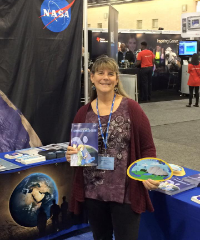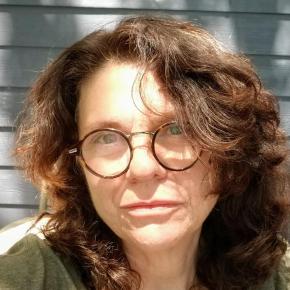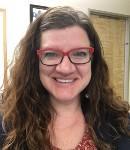Community Blogs
Community Blogs
Discover how the GLOBE community is engaging in all things GLOBE through the community blog posts below.
Learn how to create a GLOBE community blog post.
Filter By:
Blogs List
There will be a special Google hangout for GLOBE teachers and scientists on Feb 15 at 7pm (ET ). During this event, we will learn about the results of the research from several scientists who were onboard the research vessel, and will have a chance to ask questions about this work and results. http://bit.ly/2lL4Kgd
No registration required- open to any GLOBE teacher and/or scientist! Please share this!
GLOBE Educator Webinar - Feb 15, 7pm ET
Agenda below:
Overview (~45 min program)
Learn about an ongoing Earth science expedition with NASA scientists ...
Read More »
Posted in:
Curriculum:
SCIENCE AND MATH
TECHNOLOGY
Event Topics:
CAMPAIGNS AND PROJECTS (IOPS, ETC)
Field Campaigns:
EL NIÑO
GLOBE Science Topics:
EARTH AS A SYSTEM
EARTH SYSTEM SCIENCE
SCIENTIST SKILLS
GENERAL SCIENCE
CLIMATE CHANGE
CLIMATE
Investigation Areas:
ATMOSPHERE
EARTH AS A SYSTEM
HYDROSPHERE
BIOSPHERE
Learning Activities:
EARTH AS A SYSTEM
ATMOSPHERE AND CLIMATE
HYDROLOGY
News Topics:
SCRC RESEARCH
Primary Audience:
TRAINERS
TEACHERS
PARTNERS
SCIENTISTS
ALUMNI
COUNTRY COORDINATORS
GLOBE Partner the University Corporation for Atmospheric Research Center for Science Education developed 9 classroom activities to help students learn how to analyze GLOBE environmental data while also learning atmospheric science concepts and geography.
These new activities have been reviewed by science educators and staff at the GLOBE Implementation Office and, of course, they have been field tested by teachers.
I have gathered them up and linked them here. If you are going to the 2017 South Dakota Math and Science Teachers conference in Huron, this is what we will be ...
Posted in:
Curriculum:
SCIENCE AND MATH
Event Topics:
WORKSHOPS
GLOBE Science Topics:
SCIENTIST SKILLS
EARTH SYSTEM SCIENCE
Primary Audience:
TEACHERS
Have you ever wondered how NASA Earth observing satellites are able to ground truth their data? What about satellites that collect data over the ocean? Is it ever possible to compare actual in situ data with data that is collected using remote sensing? It just so happens that there are several NASA scientists who will be doing just that- and more- from January 24 th through February 20 th ! And, those of us who are involved in the GLOBE Program have been specially invited to participate in several aspects of this research.
We are going to hear from Dr. Ivona Cetinic, the lead ...
Posted in:
Curriculum:
SCIENCE AND MATH
Field Campaigns:
EL NIÑO
GLOBE Science Topics:
EARTH AS A SYSTEM
SCIENTIST SKILLS
CLIMATE CHANGE
Investigation Areas:
ATMOSPHERE
EARTH AS A SYSTEM
HYDROSPHERE
BIOSPHERE
Primary Audience:
TEACHERS
STUDENTS
SCIENTISTS
ALUMNI
I just came across an article from NASA's Earth Observatory that was released yesterday entitled " A Dry Start to South America’s Wet Season ". The article describes the current lack of precipitation in South America, and includes the map below. In this map, we are seeing the accumulated deficit of rainfall that is both flowing onto the surface and accumulating under the ground as of this October.
This got me wondering how South America might be impacted by the La Nina conditions in the near future. I did a little research, and found this article, also from NASA's Earth ...
Posted in:
Curriculum:
SCIENCE AND MATH
Field Campaigns:
EL NIÑO
GLOBE Science Topics:
EARTH AS A SYSTEM
CLIMATE
Investigation Areas:
EARTH AS A SYSTEM
HYDROSPHERE
PEDOSPHERE (SOIL)
ATMOSPHERE
BIOSPHERE
One of NASA's scientists, Dr. Stephanie Uz, has been working closely with the GLOBE ENSO Campaign throughout its beginning. She is an oceanographer who studies the response of ocean biology to physical forcing through remotely sensed satellite data, in situ measurements, model output and statistical reconstructions using proxies. Her research focuses on variability in global ocean color or chlorophyll concentrations, the pigment in microscopic phytoplankton, and the physical mechanisms causing those changes. Dr. Uz coordinates communication for the Plankton, Aerosol, Cloud, ocean ...
Posted in:
Curriculum:
EDUCATION RESEARCH
SCIENCE AND MATH
TECHNOLOGY
Field Campaigns:
EL NIÑO
GLOBE Science Topics:
EARTH AS A SYSTEM
SCIENTIST SKILLS
EARTH SYSTEM SCIENCE
CLIMATE CHANGE
CLIMATE
Investigation Areas:
ATMOSPHERE
EARTH AS A SYSTEM
HYDROSPHERE
BIOSPHERE
Learning Activities:
EARTH AS A SYSTEM
ATMOSPHERE AND CLIMATE
HYDROLOGY
Primary Audience:
TRAINERS
TEACHERS
STUDENTS
PARTNERS
SCIENTISTS
ALUMNI
COUNTRY COORDINATORS
Teacher's Guide:
INVESTIGATION AREA DOCUMENTS
Bird Beaks and What they Eat
Overview:
Students identify ideal beak shape for food.
Age:
Upper primary (4th and 5th graders) assisted 1st graders
Materials:
Bird beak/food handout
Straws
Dixie cups
Juice
Tweezers
Bowls
Wild grain rice
Slotted spoons
Cooked noodles (macaroni or similarly shaped)
Chopsticks
Gummy bears
White rice
Scissors
Marshmallows (jumbo)
Plan:
Ask students why birds have beaks and what they are used for - allow time for discussion. Read a book about beaks to the group. I used ...
Posted in:
Curriculum:
SCIENCE AND MATH
GLOBE Science Topics:
GENERAL SCIENCE
Learning Activities:
LAND COVER/BIOLOGY
Primary Audience:
TEACHERS
STUDENTS
Have you ever wondered how the SMAP satellite, with an altitude of 685 km (425 miles) above the Earth, can take measurements as precise as the amount of water in the Earth's soil?
The quick answer is that it requires precisely calibrated instruments, along with a technological marvel in satellite design.
SMAP was designed to use a combination of two precise instruments, one with high resolution, one with high accuracy.
THE INSTRUMENTS:
Active (High Resolution): SMAP’s radar was designed accurately measure the echoes of very short radio frequency (RF) pulses that bounce ...
Posted in:
Curriculum:
SCIENCE AND MATH
TECHNOLOGY
Field Campaigns:
SMAP
GLOBE Science Topics:
EARTH SYSTEM SCIENCE
Investigation Areas:
PEDOSPHERE (SOIL)
Primary Audience:
TRAINERS
TEACHERS
STUDENTS
PARTNERS
SCIENTISTS
ALUMNI
COUNTRY COORDINATORS
Weekly Report 1: 10/1/15 - 10/15/15
This report contains two weeks of data collection due to the beginning of the campaign on October 1, 2015:
Volumetric Soil Moisture Measurements = 19
Participating Sites = 4
Schools Submitting Data:
Shumate Middle School - Michigan - 8 data counts
Ramey School - Puerto Rico -7 data counts
The University of Toledo -Ohio - 2 data counts
Thomas Edison Energy/Smart Charter School - New Jersey - 2 data counts
Congratulations to those schools for getting a great start. Let's get more schools participating!
Brian
Posted in:
Curriculum:
SCIENCE AND MATH
Field Campaigns:
SMAP
GLOBE Science Topics:
GLOBE PROTOCOLS
Investigation Areas:
PEDOSPHERE (SOIL)
News Topics:
COMPETITIONS
Primary Audience:
TRAINERS
TEACHERS
STUDENTS
PARTNERS
COUNTRY COORDINATORS
A version of this blog was originally posted on November 14, 2012 .
If you have been listening to the news or following along with weather and climate web pages, you have probably heard the term "ENSO." ENSO, or El Niño-Southern Oscillation, is a quasi-periodic climate pattern that occurs in the tropical Pacific Ocean. When the conditions change, the atmosphere responds in many different ways. In certain locations, it is cloudier and it rains more, while in others it’s clear and dry. Scientists are forecasting El Niño conditions to start ...
Posted in:
Curriculum:
SCIENCE AND MATH
GLOBE Science Topics:
CLIMATE
Investigation Areas:
ATMOSPHERE
Blog originally posted on The GLOBE Scientists' Blog: http://blog.globe.gov/sciblog/2012/12/12/the-common-thread-between-science-and-art-creativity/
When you examine a seashell, a crystal, the skin of a snake or the wings of a butterfly, what do you think about? Art? Science? Or the obvious connection between the two? At the fall meeting of the American Geophysical Union (AGU) in San Francisco, CA last week, thousands of scientists, including myself, found ourselves examining the intersection of science and art through a wide variety of ...
Posted in:
Curriculum:
LANGUAGE CULTURE AND ARTS
SCIENCE AND MATH
This week we have a guest blogger, Dr. Dixon Butler. Dr. Butler was the GLOBE Chief Scientist from 1996-2003 and now works as a consultant to NASA.
Students working on GLOBE Hydrology Protocols
The general explanation of the scientific method focuses on comparing two situations that differ in only one clearly defined way. One case serves as the control while the other is the experiment. The results must be replicable as a check that the measurements were made correctly and that any other differences between the control and experiment are insignificant. This is an ...
—
20 Items per Page











